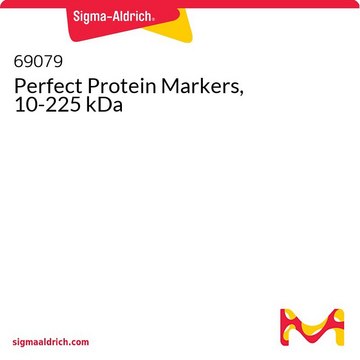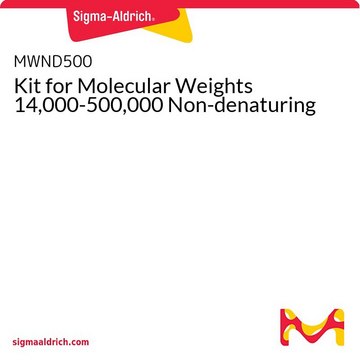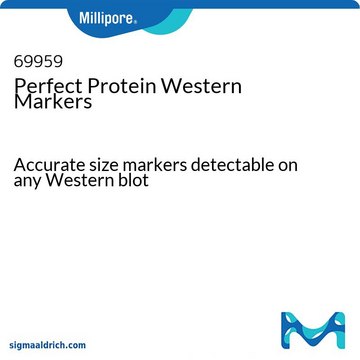S8445
SigmaMarker™
wide range, mol wt 6,500-200,000 Da
Synonym(s):
protein markers, protein standards
About This Item
Recommended Products
Quality Level
form
lyophilized powder
usage
sufficient for 10-20 large gels (16 × 18 cm)
sufficient for 20-30 mini-gels (10 × 10 cm)
vial sufficient for 50-100 PhastGels
mol wt
6,500-200,000 Da
storage temp.
2-8°C
Looking for similar products? Visit Product Comparison Guide
Application
Other Notes
Aprotinin, bovine lung (6,500)
α-Lactalbumin, bovine milk (14,200)
Trypsin inhibitor, soybean (20,000)
Trypsinogen, bovine pancreas (24,000)
Carbonic anhydrase, bovine erythrocytes (29,000)
Glyceraldehyde-3-phosphate dehydrogenase, rabbit muscle (36,000)
Ovalbumin, chicken egg (45,000)
Glutamic dehydrogenase, bovine liver (55,000)
Albumin, bovine serum (66,000)
Phosphorylase B, rabbit muscle (97,000)
β-Galactosidase, E. coli (116,000)
Myosin, porcine heart (200,000)
Reconstitution
Legal Information
related product
Signal Word
Danger
Hazard Statements
Precautionary Statements
Hazard Classifications
Eye Irrit. 2 - Resp. Sens. 1 - Skin Irrit. 2 - Skin Sens. 1
Storage Class Code
11 - Combustible Solids
WGK
WGK 3
Flash Point(F)
Not applicable
Flash Point(C)
Not applicable
Personal Protective Equipment
Certificates of Analysis (COA)
Search for Certificates of Analysis (COA) by entering the products Lot/Batch Number. Lot and Batch Numbers can be found on a product’s label following the words ‘Lot’ or ‘Batch’.
Already Own This Product?
Find documentation for the products that you have recently purchased in the Document Library.
Our team of scientists has experience in all areas of research including Life Science, Material Science, Chemical Synthesis, Chromatography, Analytical and many others.
Contact Technical Service









